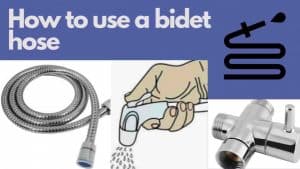Why you should not use a bidet?Understanding the Risks involved

In general, bidets are considered to be safe when used properly and with adequate hygiene measures in place. The use of a bidet can have several health benefits, including reducing the risk of urinary tract infections and others.
However, there are also potential drawbacks and risks to consider, such as skin irritation, increased risk of infections, and discomfort from the sensation of water pressure.
In this article, we will explore the various risks associated with using bidets and how to minimize them.
See also:
- How Bidets Can Help Alleviate Hemorrhoid Symptoms
- What Is The Bidet Good For? 18 Advantages You Can’t Ignore
Understanding the potential Risks of Using a Bidet.
Using a bidet properly is generally safe and not harmful but also there are some potential risks [source] such as:
Skin irritation:
If someone has sensitive skin, a bidet may not be suitable for him. A bidet should be used with some precautions if you have sensitive skin [source]. High water pressure or temperature can irritate the skin, especially in sensitive areas such as the genital area.
Additionally, the use of harsh soaps or chemicals can further irritate the skin and lead to discomfort. If you experience skin irritation after using a bidet, it is advisable to look out for the proper use of a bidet for sensitive skin. In most cases, changing the temperature or pressure setting will resolve the problem.
Increased Risk of Infections:
Bidets, when not properly cleaned and maintained, can cause infections, especially urinary tract infections (UTIs). Bacteria and other microorganisms can accumulate in the nozzle, causing diseases. High humidity in the bathroom can also encourage mold and mildew growth, which contributes to infection spread [source].
It’s important to regularly clean and sanitize your bidet and keep your bathroom well ventilated to prevent infections.
Physical Injury from High Pressure or Temperature:
It is possible to be injured by the high-pressure water streams coming from some bidets if they are not used properly. Particularly if they have any medical conditions that make them more sensitive to water pressure or heat.
Individuals with hemorrhoids or other rectal conditions may find high-pressure water streams uncomfortable or even painful. Similarly, hot water can cause burns or other injuries [source].
To avoid physical injury from a bidet, it is important to adjust the pressure and temperature settings to a comfortable level and to use caution when adjusting these settings.
Lack of Proper Cleaning and Maintenance:
Bidets that are not cleaned and maintained can become infested with bacteria and other microorganisms. Without regular cleaning and maintenance, bidets can pose a significant health risk [source].
The accumulation of bacteria and other microorganisms can cause disease, while mineral deposits and other debris can clog the nozzle and make the bidet inoperable. It is recommended to follow the manufacturer’s guidelines to clean and maintain your bidet regularly so that it remains safe and effective.
Improper drying after use:
The importance of drying yourself and your bidet after each and every use cannot be overstated. When the bidet is not properly dried after use, it can cause an environment that is conducive to the growth of bacteria and other microorganisms.
As a result of the moisture that accumulates on the bidet and its surrounding surfaces, mold and mildew can grow and this may pose a risk to the health of users [source]. To reduce the risk of health problems, it is imperative to thoroughly dry the bidet and surrounding surfaces after each use and to keep the bathroom well-ventilated.
Potential Risks Associated with Bidet Use and Mitigating Steps
| Feature/Benefit | Reason for Potential Harm | Mitigating Steps |
| High Pressure | Can cause skin irritation or injury, particularly for individuals with sensitive skin or rectal conditions | Adjust pressure to a comfortable level and use caution when adjusting |
| High Temperature | Can cause burns or other injuries, particularly for individuals with medical conditions that make them more sensitive to heat | Adjust temperature to a comfortable level and use caution when adjusting |
| Lack of Cleaning and Maintenance | Can increase the risk of infections and the spread of diseases | Clean and sanitize the bidet regularly, following the manufacturer’s recommended guidelines |
| Improper Drying | Can create an environment conducive to the growth of bacteria and other microorganisms | Thoroughly dry the bidet and surrounding surfaces after each use and keep the bathroom well-ventilated |
Note: The information provided in the table is for general purposes only and is not intended to be a comprehensive guide to the use of bidets. It is important to always follow the manufacturer’s recommended guidelines and to consult with a healthcare professional before using a bidet if you have any medical concerns or conditions.
SHOULD WE USE A BIDET OR NOT?
- The decision to use a bidet or not is a personal one that is influenced by personal tastes and requirements.
- Some people think that using a bidet enhances their personal hygiene and comfort, while others may dislike having water aimed at sensitive places
- Bidets are generally regarded safe and can provide health advantages when used appropriately and with sufficient cleanliness.
However, like with any personal hygiene appliances, there are hazards and adverse effects of all them, but they need to be aware of. But to use or not use a bidet is based on a comprehensive assessment of the one’s requirements and preferences, as well as any health problems or conditions.
Ultimately, the decision to use a bidet or not should be based on a careful consideration of the individual’s needs and preferences, as well as any health concerns or conditions. If you have a medical issue and you are considering using a bidet, it is recommended to speak with a healthcare provider to determine if it is appropriate for you and to receive advice on proper use and hygiene.
The Bottom Line
If you don’t have any medical issue associated with the use of bidet, then a bidet is the best for your personal hygiene and cleanliness. But, it is important to be aware of the potential risks involved in using a bidet. Understanding these risks and taking the proper precautions can help ensure that you have a safe and hygienic bidet experience. For example, maintaining good hygiene by thoroughly washing your hands before and after using the bidet, and regularly cleaning the bidet itself, can help reduce the risk of infection.
In the end, the decision to use a bidet is a personal one, and it is up to each individual to weigh the benefits and risks and make an informed decision. Whether you choose to use a bidet or not, it is always important to maintain good hygiene and practice safe habits in the bathroom.





